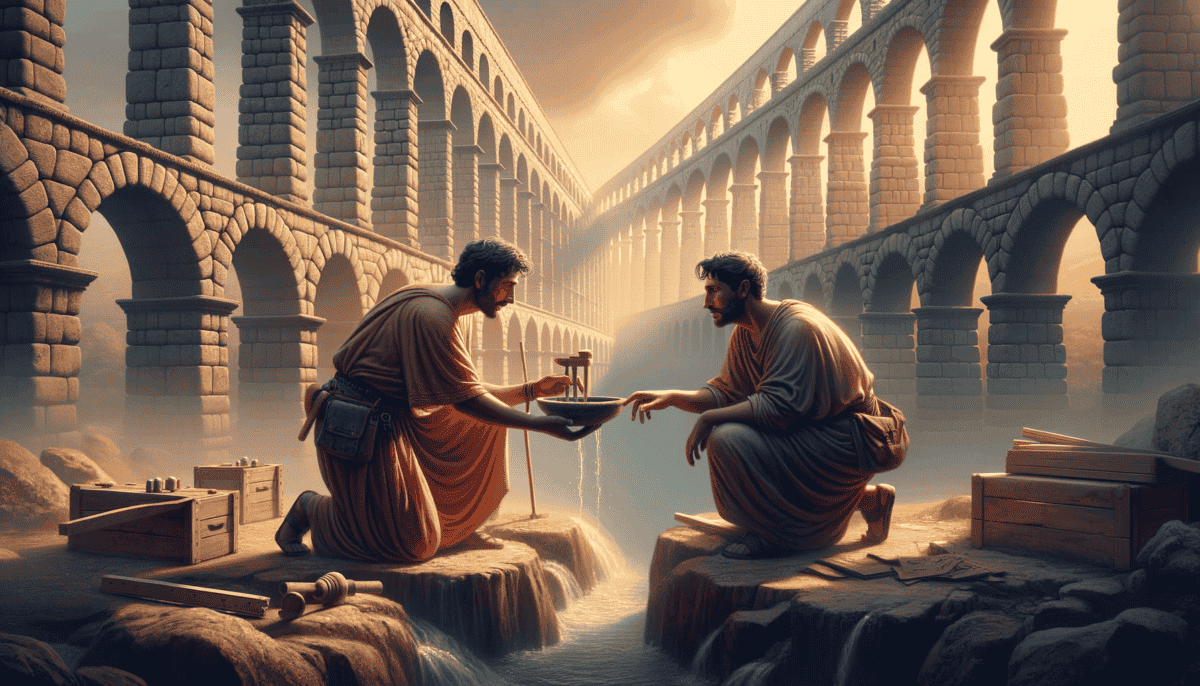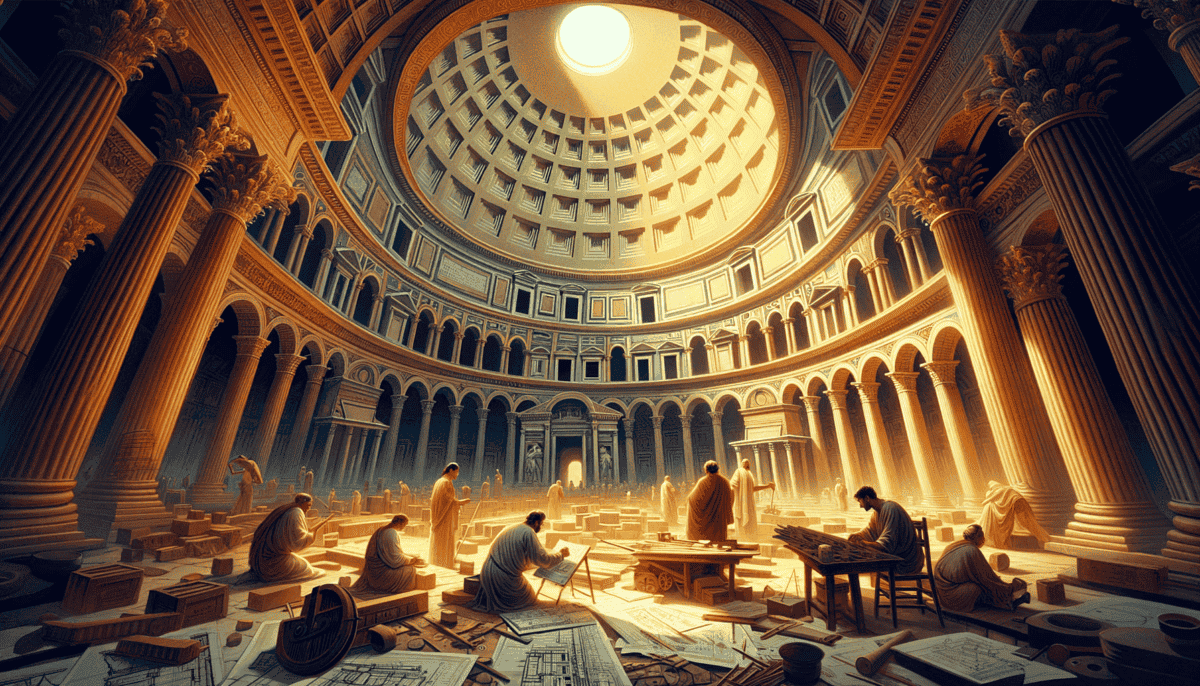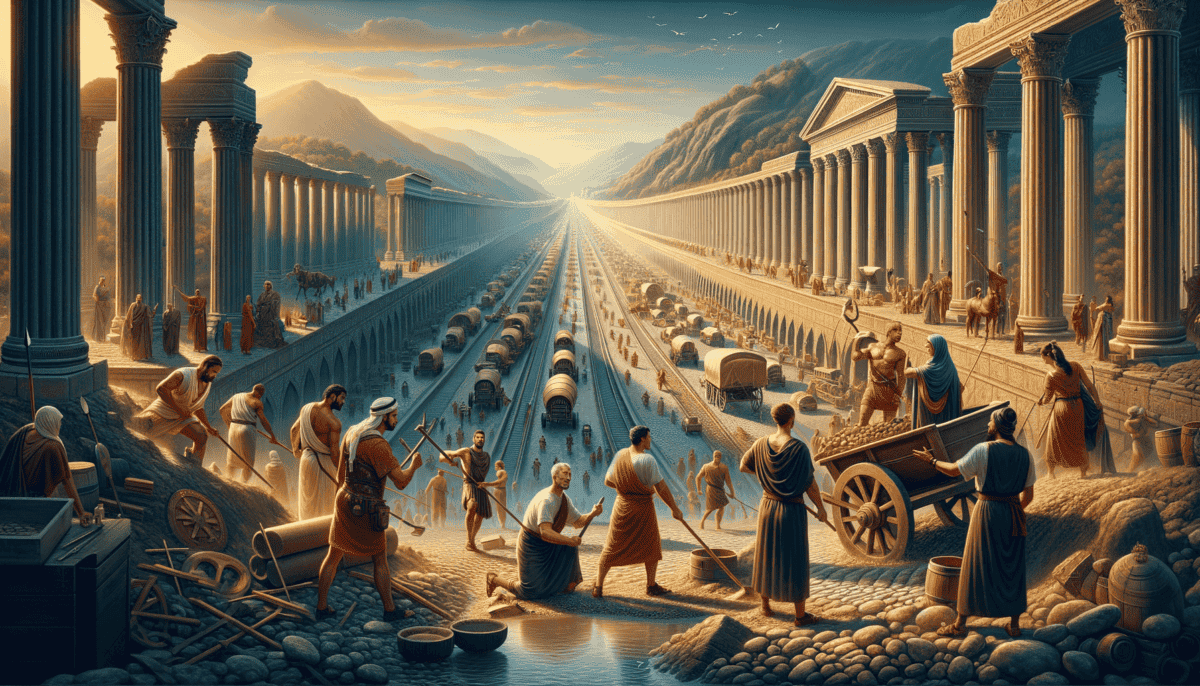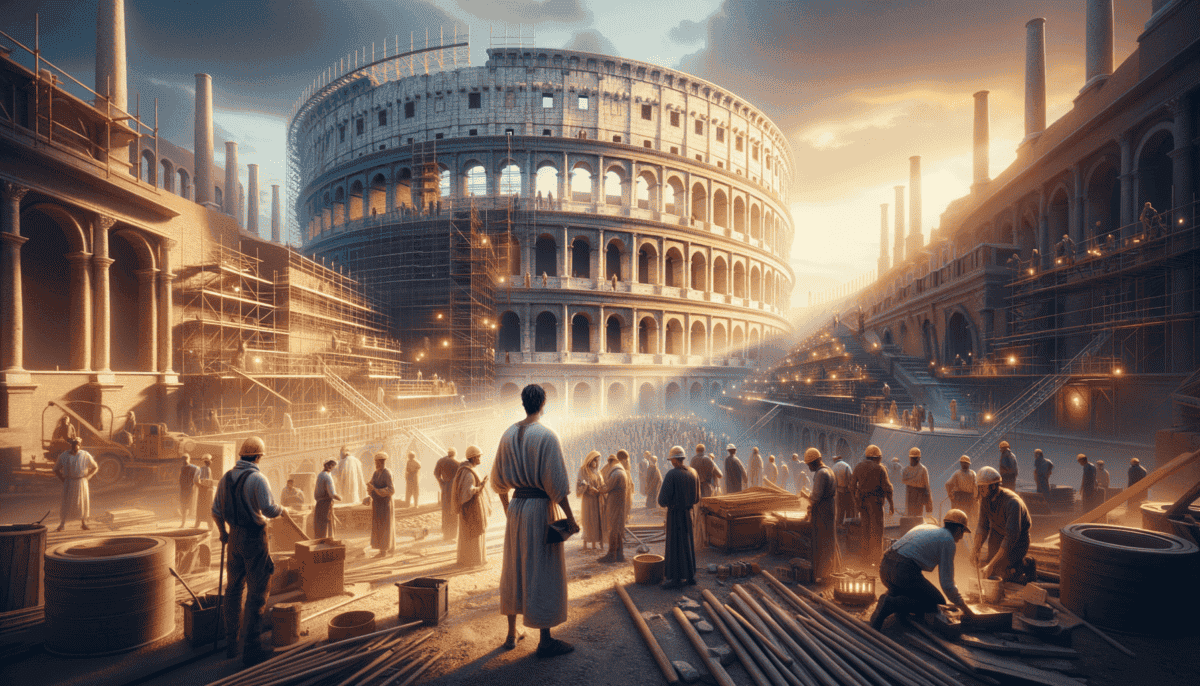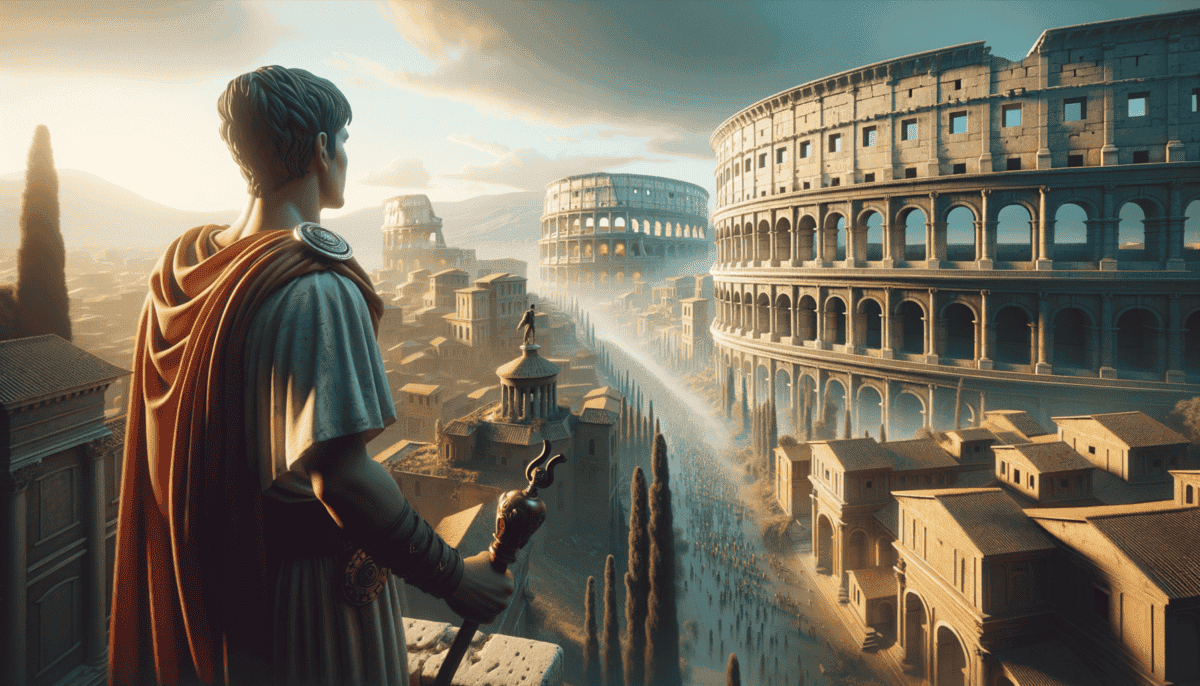The Curious Stone Cutter
The morning sun cast long shadows across the Roman quarry as Marco wiped sweat from his brow. At twelve years old, he was the youngest apprentice working among the seasoned stone cutters. His small hands gripped the chisel tightly as he watched his father demonstrate the proper technique.
"Watch carefully, my son," said Marcus, his father's weathered face creasing into a smile. "The stone speaks to us if we listen."
Marco loved these early morning lessons. The quarry was quiet except for the rhythmic tapping of metal on stone. The air smelled of fresh-cut limestone and morning dew.
"Father, why does this stone feel different?" Marco asked, running his fingers along a pale yellow block. His curious nature always made him ask questions.
Marcus knelt beside his son. "Ah, you have a good eye! This is travertine – one of our most special building stones. It's what makes our greatest buildings strong and beautiful."
The other workers smiled at Marco's enthusiasm. They had watched him grow up in the quarry, following his father like a shadow since he could walk.
"Tell me about the buildings again, Father," Marco begged, his eyes shining with excitement.
Marcus chuckled and set down his tools. "Well, let me tell you about the greatest buildings in Rome…" He pointed to the city visible in the distance. "See those tall columns? Those are made from the very stones we cut here."
The Magic of Roman Concrete
Later that day, Marco watched the concrete makers at work. They mixed:
• Limestone powder
• Volcanic ash
• Water
• Small rocks
"It's like magic!" Marco exclaimed as he watched the grey mixture turn hard as stone. The concrete maker, Flavius, laughed.
"Not magic, young Marco – it's science! The volcanic ash makes our concrete special. It can even harden underwater!"
Marco dipped his finger in the wet mixture, earning a playful swat from Flavius. "Careful there, curious one! Soon you'll be ready to learn the secret recipes."
As the sun began to set, Marco helped his father clean their tools. His arms were tired, but his mind was full of dreams about the amazing things he would build one day.
"Father," he said quietly, "do you think I could become a master builder someday?"
Marcus placed a strong hand on his son's shoulder. "With your curious mind and willing hands, you could build things that will last forever. Remember, Rome wasn't built in a day – and neither is a master builder."
That night, Marco fell asleep dreaming of mighty buildings rising from the stones he would cut. Little did he know, his journey to become one of Rome's greatest builders was just beginning. ️
Secrets of the Aqueduct Builders
Two years had passed since Marco’s first lessons in the quarry. Now fourteen, he stood at the base of a towering aqueduct, his neck craned upward in awe. The massive stone arches stretched across the valley like a giant’s bridge.
“Welcome to your new training ground!” called out Lucius, the chief aqueduct engineer. His voice echoed off the stone pillars. “Your father says you’re ready to learn something new.”
Marco’s heart raced with excitement. This was his chance to work on something bigger than quarry stones. The construction team buzzed with activity around him.
Learning New Skills
“First lesson,” Lucius announced, pulling out a strange tool. “This is a water level. Watch carefully.” He demonstrated how the water inside the clear tube helped keep everything straight and level.
The basic steps for building an aqueduct were:
• Dig strong foundations
• Build stone arches
• Line the water channel
• Test the water flow
• Fix any leaks
“But Master Lucius,” Marco asked, “how does the water know which way to flow?”
Lucius smiled. “Ah, that’s the clever part! We build with a slight slope – just enough for water to flow downhill to Rome. It’s like a very long, very gentle slide.”
Working as a Team
Marco quickly learned that building aqueducts was all about teamwork. Each person had an important job:
“The surveyors plan the route,
The diggers prepare the ground,
The stone layers build the arches,
And the cement makers seal it all together!”
“Pass me that measuring rod!” called Julia, one of the surveyors. Marco hurried to help. She was teaching him how to calculate the perfect arch shape.
“You’ve got quick hands and a quick mind,” she noted. “Those are good traits for an engineer.”
Solving Problems
One day, the team faced a big challenge. The water wasn’t flowing properly through a section of the aqueduct. Marco watched as the builders scratched their heads.
“Maybe…” Marco spoke up shyly, “maybe we could check the slope again? I noticed the ground shifted a bit after the last rain.”
Lucius raised his eyebrows. “Good thinking! Let’s check it out.”
Sure enough, Marco was right. The team spent the next day adjusting the stone blocks until the water flowed perfectly.
“You see,” Lucius said proudly, “building isn’t just about strength. It’s about paying attention to small details.”
A Growing Reputation
As the months passed, Marco learned more and more. He could now:
✓ Mix the perfect waterproof cement
✓ Calculate arch measurements
✓ Spot problems before they got big
Word spread about the young apprentice who could solve tricky building problems. Even the senior builders started asking for his opinion.
“You remind me of myself at your age,” Lucius told him one evening. “Always watching, always thinking of better ways to do things.”
Marco beamed with pride. As the sun set behind the mighty aqueduct, he thought about how far he’d come from his days in the quarry. But this was just the beginning – bigger challenges and greater buildings awaited him in Rome. The Pantheon project was starting soon, and Marco’s growing skills would soon be put to an even bigger test. ️
The Pantheon’s Hidden Mysteries
Marco couldn’t believe his eyes. The Pantheon’s construction site was massive! ️ The morning sun cast long shadows across piles of stone and wood scaffolding that reached toward the sky.
“Welcome to Rome’s greatest project,” said Claudius, the head architect. His gray beard and weathered face showed years of experience. “Lucius tells me you have a special talent.”
Marco looked around in wonder. Workers mixed concrete in huge wooden tubs. Others carefully shaped massive stone blocks. The air buzzed with activity and excitement.
A New Challenge
“Your first task,” Claudius pointed upward, “is to help us solve the dome puzzle. We need concrete that’s strong but not too heavy.”
“Too heavy?” Marco asked.
“Yes! If it’s too heavy, the whole roof might fall down. CRASH!” Claudius clapped his hands, making Marco jump.
Marco remembered something from his quarry days. “What if we mix in light rocks, like pumice?”
Testing Ideas
Not everyone liked Marco’s suggestions. Flavius, an older builder, crossed his arms. “That’s not how we do things!”
But Claudius smiled. “Let’s test it. Show us, Marco.”
• Regular concrete mix
• Lightweight pumice stones
• Extra volcanic ash
• Just the right amount of water
They made test blocks and waited. Days passed. The lightweight blocks stayed strong!
Building Higher
“Look how the walls curve!” Marco exclaimed, studying the dome’s shape. It reminded him of a giant egg cut in half.
Claudius nodded. “The higher we go, the thinner we make the walls. Like your concrete, everything must be just right.”
Then one day, disaster struck. A section of scaffolding creaked dangerously.
“Everyone back!” Marco shouted. His quick warning helped workers move to safety just before wooden beams crashed down.
A Bright Idea
That night, Marco couldn’t sleep. He kept thinking about the dome’s weight. Then it hit him!
“What if we add special patterns?” he told Claudius the next morning. “Like squares and circles in the concrete? They would make it lighter without making it weaker!”
Claudius’s eyes lit up. “You mean like a waffle? Show me more!”
Marco drew his idea in the dirt. These patterns, called coffers, would become one of the Pantheon’s most beautiful features.
Success at Last
Months passed. The dome grew higher and higher. Marco’s special concrete worked perfectly. Even Flavius had to admit it was clever.
“You’ve done something remarkable,” Claudius said, patting Marco’s shoulder. “This building will stand for centuries.”
Marco smiled, watching workers add the final touches to the great dome. But deep inside, he knew there were still more challenges ahead. The empire needed roads to connect its cities, and Marco’s skills would soon be tested in new ways. ️
Roads of the Empire
The morning sun beat down on Marco as he studied the map spread before him. Tiny lines marked where new roads would connect Rome to distant cities. ️
“These roads must last forever,” said Commander Titus, pointing at the map. “Can you do it?”
Marco nodded confidently. After his success at the Pantheon, he now led his own team of builders.
The Great Challenge
“Roads are different from buildings,” Julia, Marco’s newest helper, said. She was smart and curious, just like Marco had been as an apprentice.
“You’re right,” Marco smiled. “Roads must be strong enough for armies, wagons, and traders. They can’t break when it rains or gets hot.” ☀️
Building the Perfect Road
Marco gathered his team. “Watch carefully,” he said, showing them how to build the perfect Roman road:
• Big stones at the bottom
• Gravel in the middle
• Small flat stones on top
• Sloped sides for rain to run off
“But why so many layers?” Julia asked.
“Each layer has a job,” Marco explained. “Like the different parts of a sandwich!”
Problems and Solutions
One day, they hit trouble. The ground was too soft and muddy.
“The road will sink!” worried Felix, another worker.
Marco thought hard. Then he remembered something from the Pantheon. “We’ll make a special foundation, like we did for the dome!”
They dug deeper and added extra layers of stone. The road stayed strong and straight.
Racing Against Time
Commander Titus visited often. “The Emperor needs these roads finished quickly,” he said. “Our armies must move fast!”
Marco’s team worked harder. They learned to measure perfectly straight lines using special tools. They built clever drains to keep the roads dry.
“Look!” Julia pointed one morning. “You can see all the way to the hills!” The road stretched out like a giant stone ribbon.
More Than Just Roads
As they worked, Marco added special features:
“We’ll put mile markers here,” he said, “so travelers know how far they’ve gone.”
“And rest stops here,” he added, “where people can sleep and get fresh horses.”
The Big Test
Finally, the first major road was ready. Marco watched nervously as a heavy wagon rolled down their road.
“It’s so smooth!” the wagon driver called out. “Like riding on clouds!”
Commander Titus looked pleased. “The Emperor will hear about this, Marco. Your roads will help build our empire.”
Marco felt proud, but he was already thinking ahead. He had heard about an amazing new project in Rome – the biggest arena ever built. His roads were important, but the Colosseum would be his greatest challenge yet. ️
Dreams of Stone and Glory
The massive skeleton of the Colosseum rose into the blue Roman sky. Marco stood at its base, feeling tiny next to the huge stone arches. ️
“It will be the greatest building in Rome,” Emperor Vespasian declared, his voice full of pride. “Can you help make it happen, Marco?”
A New Challenge
Marco’s heart raced with excitement. This was bigger than anything he’d ever built – even the Pantheon!
“We’ll need special concrete,” he told Julia, who had followed him from the road project. “And lots of it!”
Building the Dream
Marco gathered his team early one morning. “This building has to be special,” he explained. “People will come from all over to watch shows here!”
“But how will so many people get in and out?” Julia asked wisely.
Marco smiled and rolled out his plans. “Look here – we’ll make 80 entrances! Like a big wheel with spokes.”
Clever Solutions
Every day brought new problems to solve:
• Special curved walls for strength
• Underground tunnels for animals and fighters
• Clever shade covers for sunny days
• Secret passages for important people
“The seats must be comfortable,” Marco insisted. “And everyone needs to see well!”
Trouble Strikes
One morning, Marcus Severus, another builder, stormed up to Marco. “Your design won’t work! The walls will fall!”
“They won’t,” Marco said calmly. “Watch this.” He showed how the arches would share the weight, just like a group of friends holding hands in a circle.
Racing to Finish
The work was hard. Workers hauled giant blocks of stone up tall wooden towers. Others mixed huge batches of special concrete.
“Faster!” shouted the supervisors. “The Emperor wants to see games here soon!”
But Marco wouldn’t rush. “Better to build it right than build it fast,” he told his team.
The Big Day
Finally, after years of work, the Colosseum was ready. Marco stood in the arena, looking up at the huge walls he had helped build.
“It’s beautiful,” Julia whispered, her voice full of awe.
The Emperor walked in, his golden robe shining in the sunlight. He looked around slowly, then smiled.
“You’ve built more than an arena, Marco,” he said. “You’ve built a symbol of Rome’s greatness!”
That night, watching the first games from a special seat, Marco thought about his journey. From cutting stone as a boy to building Rome’s greatest arena – he had come so far! But something told him his greatest work wasn’t finished yet. There were still more wonders to build, more problems to solve.
A Legacy Written in Stone
Years had passed since the Colosseum first opened its doors. Marco, now with grey in his hair, stood on the Palatine Hill, looking out over Rome. The city sparkled in the morning sun like a jewel.
Teaching the Next Generation
“Tell us about building the Colosseum again!” begged a group of young apprentices gathered around him.
Marco smiled. “First, you must understand that every great building starts with a dream and good materials.” He picked up a piece of concrete. “This is what made Rome great.”
Julia’s Big News
Julia, now Marco’s trusted partner, rushed up the hill. “Marco! The Emperor wants us to build a new bath house!”
“Perfect!” Marco clapped his hands. “A chance to show our apprentices everything we’ve learned.” ️
Sharing Secrets
Marco gathered his students around a work table. “Let me show you what I’ve discovered over the years.”
• Mix volcanic ash with lime for strong concrete
• Use arches to support heavy weights
• Build strong foundations first
• Work as a team
A Special Discovery
“Look what we found!” called one excited apprentice. She held up an old stone-cutting tool – just like the one Marco had used as a boy.
“That reminds me of where I started,” Marco said, touching the worn tool. “From simple stones to the mighty Colosseum.” ️
The Greatest Monument
“What’s the best thing you ever built?” asked a young boy.
Marco looked around at his students. “Not what – who. I built builders. You are my greatest work.”
Looking to Tomorrow
That evening, Marco and Julia walked through Rome’s busy streets. The buildings they had helped create stood tall and proud around them.
“Our buildings will last forever,” Julia said.
“And so will our knowledge,” Marco added. “As long as people dream of building great things.”
A group of children ran past, playing with toy blocks. Marco watched them stack the blocks higher and higher.
“Look!” he smiled. “The next generation of builders.”
As the sun set behind the Colosseum, Marco knew that Rome’s greatest gift wasn’t just its buildings – it was showing what people could achieve when they worked together and dared to dream big. The spirit of innovation and creativity would live on, inspiring builders for thousands of years to come. ⭐
The ancient stones would keep their secrets, but the dream of building amazing things would never end. And somewhere, another young person was looking at a piece of stone, wondering what incredible things they could create.


